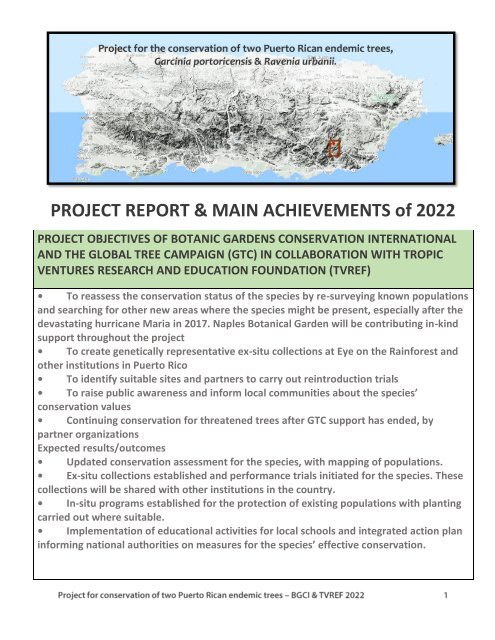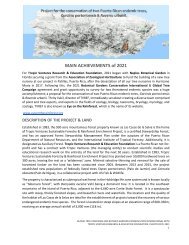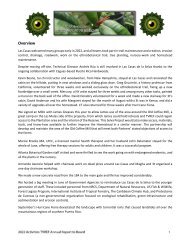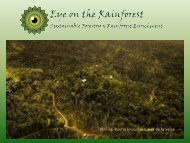Create successful ePaper yourself
Turn your PDF publications into a flip-book with our unique Google optimized e-Paper software.
PROJECT <strong>REPORT</strong> & MAIN ACHIEVEMENTS of <strong>2022</strong><br />
PROJECT OBJECTIVES OF BOTANIC GARDENS CONSERVATION INTERNATIONAL<br />
AND THE GLOBAL TREE CAMPAIGN (GTC) IN COLLABORATION WITH TROPIC<br />
VENTURES RESEARCH AND EDUCATION FOUNDATION (TVREF)<br />
• To reassess the conservation status of the species by re-surveying known populations<br />
and searching for other new areas where the species might be present, especially after the<br />
devastating hurricane Maria in 2017. Naples Botanical Garden will be contributing in-kind<br />
support throughout the project<br />
• To create genetically representative ex-situ collections at Eye on the Rainforest and<br />
other institutions in Puerto Rico<br />
• To identify suitable sites and partners to carry out reintroduction trials<br />
• To raise public awareness and inform local communities about the species’<br />
conservation values<br />
• Continuing conservation for threatened trees after GTC support has ended, by<br />
partner organizations<br />
Expected results/outcomes<br />
• Updated conservation assessment for the species, with mapping of populations.<br />
• Ex-situ collections established and performance trials initiated for the species. These<br />
collections will be shared with other institutions in the country.<br />
• In-situ programs established for the protection of existing populations with planting<br />
carried out where suitable.<br />
• Implementation of educational activities for local schools and integrated action plan<br />
informing national authorities on measures for the species’ effective conservation.
Background<br />
The work for the conservation of two Puerto Rican endemic trees,<br />
Garcinia portoricensis & Ravenia urbanii, began in 2021. Thrity Vakil,<br />
director of Tropic Ventures Research & Education Foundation<br />
(TVREF), and a diverse Puerto Rican team comprised of plant and<br />
tree experts, as well as experts in the fields of ecology, biology,<br />
taxonomy, bryology, mycology, and zoology, are continuing the<br />
work. TVREF is also known as Eye on the Rainforest, which is the<br />
name of its website. www.eyeontherainforest.org<br />
TVREF obtained a grant from the Association of Zoological<br />
Horticulture through Naples Botanical Gardens, in 2021, and<br />
architect David Henebry designed and led the building-work of a<br />
new, strong, hurricane-resistant shade-tree nursery with cement<br />
footings. This structure, seen below, survived the recent and<br />
devastating Hurricane Fiona in September <strong>2022</strong>, which caused<br />
devastating landslides on the project land and surrounding areas.<br />
See this link for all team Bios<br />
PUBLICATIONS<br />
Permaculture Design: https://drive.google.com/file/d/1UQBFIxwxpMlp9U3ONC9SiZhacotsIIIZ/view?usp=sharing
Acta Científica: Una revista transdisciplinaria de Puerto Rico y el Caribe.<br />
Tribute to Forester Frank H. Wadsworth, (friend and mentor to Thrity), who passed away age 106, on the 5 th of January<br />
<strong>2022</strong>. Thrity wrote a tribute essay which was published in Acta Cientifica.<br />
https://drive.google.com/file/d/13TXdSCO2TcSf7DO7BM2GFpVqUDksqPOu/view?usp=sharing<br />
PRESS: Telemundo TV Interview at Las Casas de la Selva, 9 th Dec <strong>2022</strong><br />
Kaly Esther Torro and Sebastian Marquez spent the morning with Thrity Vakil and Andrés Rúa at the woodyard in<br />
Caguas, and the afternoon at Las Casas, talking about wood and forestry in Puerto Rico. A myriad of topics from trees,<br />
wood, forests, nurseries, biodiversity, collaboration with <strong>BGCI</strong> & Naples Botanical Gardens, protection and propagation<br />
of endemic species, watershed protection, the history and work of Las Casas de la Selva since 1983, how Puerto Rico<br />
Hardwoods came into being in 2012, and what sustainable forestry looks like in Puerto Rico.
PRESENTATION<br />
Thrity was invited by the directors of the Botanical Gardens Conservation International, and Naples Botanical Garden, to<br />
the Botanical Bridges Congress <strong>2022</strong>, at The Leon Levy Native Plant Preserve, a 30-acre world-class, botanic garden in<br />
Governor’s Harbor, Eleuthera Island, Bahamas. It is a showcase of native and endemic Bahamian plants and is the first<br />
and only national park on the island. Thrity’s presentation at the congress highlighted the history and forestry work at<br />
Las Casas, including the last two years of work with critically endangered endemic species.
SURVEY #1 (April 3 rd <strong>2022</strong>)<br />
BOTANICAL SURVEYS <strong>2022</strong><br />
Getting the team together from all over the island is helped by promising a good wholesome dinner on return from the field, and<br />
this expedition was on International Chocolate Mousse Day, so we had Monique Nieves, our chef seek out pure Puertorican cacao<br />
and make us the best chocolate mousse ever. This survey covered the north valley of the project homestead. We are logging all our<br />
finds on INaturalist, and on this particular expedition we found none of our target species.<br />
L-R: Kurt Miller, Steve Maldonado, Bill Davidowski, Jaime Suarez and Alexandra Hertell, Magha Garcia, Roqui Bello, Amelia Merced.<br />
Google Photos: https://photos.app.goo.gl/pRQRcW9N1zDEAtyi9
SURVEY #2 (1 ST MAY <strong>2022</strong>)<br />
This expedition was soley to obtain cuttings from our known<br />
Ravenia and Garcinia, and try Root Riot and Clonex.
CUTTINGS<br />
Garcinia portoricensis:<br />
1 st May <strong>2022</strong>:<br />
TOTAL: 33 cuttings<br />
26 with Clonex Rooting hormone into Root Riot<br />
7 with Clonex Rooting hormone into peatmoss/perlite<br />
mix<br />
By DEC <strong>2022</strong><br />
10 out of 26 survive with Clonex and Rooting Riot<br />
0 out of 7 survive with Clonex Rooting hormone into<br />
peatmoss/perlite mix<br />
Ravenia urbanii<br />
TOTAL: 52 cuttings<br />
16 with Clonex Rooting hormone into Root Riot<br />
12 with Clonex Rooting hormone into peatmoss<br />
14 with Clonex Rooting hormone into peatmoss/perlite<br />
mix<br />
By DEC <strong>2022</strong><br />
2 out of 16 survive with Clonex and Rooting Riot<br />
0 out of 12 survive with Clonex Rooting hormone into<br />
peatmoss<br />
0 out of 14 survive with Clonex Rooting hormone into<br />
peatmoss/perlite mix<br />
GOOGLE PHOTOS: https://photos.app.goo.gl/ifAySwnT26xmcRwt7
SURVEY #3 (10th MAY <strong>2022</strong>) no target species found<br />
r<br />
L-R: Steve Maldonado, Giovanna Berrios, Magha Garcia, Fernando Rocha, Sarah Wetterer, Octavio Rivera, 3t Vakil<br />
GOOGLE PHOTOS: https://photos.app.goo.gl/jR7JNGC94xDSxVcu6
Survey #4 (7 th June <strong>2022</strong>)<br />
No new target species found. We went to see the two Garcinia trees we<br />
knew, and observed flowering, but no fruits.<br />
Endemic snail seen for the first time ever at the project, Platysuccinea portoricensis on the Garcina portoricensis
Anolis krugi, the Olive Bush Anole, also found on the Garcinia portoricensis tree<br />
GOOGLE PHOTOS: https://photos.app.goo.gl/bS9YDDNCGm1pY5b98<br />
Survey #5 10 th June <strong>2022</strong><br />
Voucher specimen of Garcinia portoricensis collected with Professor Jim<br />
Ackerman for the University of Puerto Rico herbarium.<br />
GOOGLE PHOTOS: https://photos.app.goo.gl/tT8HpXxg2QycppZ68
Survey #6 11 th June <strong>2022</strong><br />
Puerto Hermina, Quebradillas, North PR. Seed collection.<br />
Garcinia portoricensis fruits
L-R front: Eugenio Santiago, Amelia Merced, Magha Garcia, Carlos Laboy, 3t Vakil, Kurt Miller<br />
L-R back: Ricky Liquet Gonzalez, Octavio, Alejandro Cubinia, Kurt Miller<br />
GOOGLE PHOTOS: https://photos.app.goo.gl/Us6w9tfKhjKXiJ4j6<br />
The Puerto Hermina, Quedradillas site has 9 adults, 5 are females.<br />
From the other age classes 23 are saplings and >50 seedlings, which vary in number from year to year from natural<br />
death causes or trampling by hikers. Agronomist Alcides L. Morales-Pérez (personal communication) confirms this<br />
info. (He is the manager of the Reserva Natural Hacienda La Esperanza at Para la Naturaleza, northeast PR).<br />
We collected 74 fruits from the ground. Abundant fruits on the ground in public area on rocky cliff ground on the sea<br />
front. We collected 11 fruits from a forest trail not far from first collection of trees.<br />
AS of December <strong>2022</strong> all Garcinia p. seeds have germinated and are growing<br />
very well. 85 TOTAL
Playa Puerto Hermina, Quedradillas. THIS IS NOT A PROTECTED AREA<br />
GOOGLE PIN: https://goo.gl/maps/RXQNjz1MX3Jsrwhn7<br />
It is possible that the plants we have growing now are actually two different species within the same<br />
genus. Many plant species have a lot of variation within them, and granted it is not uncommon for<br />
individuals within a species to have different characteristics. The images below show the differences in seed size and<br />
form.<br />
Left: Image shows size and shape of Garcinia portoricensis fruit from LC Las Casas & LUQ Luquillo.<br />
Center: Image shows seeds from LC/LUQ on left and seeds from Q Quebradillas & SJ San Juan on right.<br />
Right: Image shows fruit size and shape of Garcinia portoricensis fruit from Q Quebradillas & SJ San Juan.<br />
The seedlings from Quebradillas and the offspring from San Juan (Q Quebradillas & SJ San Juan) are from larger round<br />
fruits and noticeably larger seeds than the seedlings from the NE side of PR (LC Las Casas & LUQ Luquillo) which are<br />
from small ovoid fruits and small seeds. Could this be a different species? With four sets of seeds and plants currently<br />
in growth and the ability to compare leaf shape, there is undoubtedly a topic requiring additional research.
Garcinia portoricensis seedlings propagated in 2021 TOTAL: 111<br />
67 x Seedlings from Luquillo<br />
LUQ (El Yunque) parent<br />
Seen from above<br />
2 x Seedlings from<br />
Las Casas project<br />
land LC<br />
Seen from above<br />
9 x Seedlings from<br />
Quebradillas SJ<br />
Parent grown in San Juan<br />
Seen from above<br />
33 x Seedlings from<br />
Quebradillas Q<br />
Seen from above
GARCINIA PORTORICENSIS DISTRIBUTION IN AND AROUND PUERTO RICO<br />
Rio Grande: Garcinia portoricensis tree with seedlings by Roqui Bello<br />
4 x adults trees, some seedlings<br />
PHOTOS : https://drive.google.com/drive/folders/1EijjV_ZG-WSJKVSBvJutTC7mV1HkWbQY?usp=share_link<br />
Rio Grande<br />
GOOGLE PIN: https://maps.app.goo.gl/gb8EuWvwQufdBGgz5?g_st=iw<br />
GOOGLE EARTH:<br />
Garcinia_portoricensis_Rio_Grande.kmz
Rio Sabana: Garcinia portoricensis tree with seedlings by Roqui Bello<br />
7 x adult trees<br />
PHOTOS: https://drive.google.com/drive/folders/1sU9NHvOmrGHxX5Yhruvvx5u0WEV49csT?usp=share_link<br />
Sabana Recreation Area, Rio Sabana, Naguabo<br />
GOOGLE PIN: https://maps.app.goo.gl/RH47NTiSZsbg9vtu6?g_st=iw<br />
GOOGLE EARTH:<br />
Garcinia-Byrsonima_Rd_191_Naguabo.kmz
Quebrada Grande: Garcinia portoricensis tree with seedlings by Roqui Bello<br />
GOOGLE PIN: https://maps.app.goo.gl/fdyJuwVvo6ukyq416?g_st=iw<br />
Balneario de Cerro Gordo, Vega alta: Garcinia portoricensis report from Erid Román Rosario<br />
5 x adult trees, 5 x seedlings<br />
GOOGLE PIN: https://goo.gl/maps/G9s81orjmf8hf3bR8
Cerro Gordo, Sabana, Vega Alta 00646: Garcinia portoricensis report from Erid Roman Rosario<br />
10 x adult trees<br />
18°28'45.7"N 66°19'21.4"W<br />
GOOGLE PIN: https://goo.gl/maps/w4AiLgez6qCRF3i47<br />
Garcinia portoricensis <strong>2022</strong> seedlings and cuttings sprouting
Ravenia Urbanii 6 x Seeds propagated July 2021 (5 germinated, first one germinated 32 days later, the<br />
other 4 took 17 months, finally germinating in Dec <strong>2022</strong>)<br />
Out of 52 cuttings 2 cuttings survived so far.
IMAGES<br />
IMAGES FROM OUR <strong>2022</strong> TREE SURVEYS<br />
#1 GTC Survey, 3rd April <strong>2022</strong> Las Casas land https://photos.app.goo.gl/pRQRcW9N1zDEAtyi9<br />
#2 GTC Survey, 1st May <strong>2022</strong> cuttings Las Casas land https://photos.app.goo.gl/ifAySwnT26xmcRwt7<br />
#3 GTC Survey, 10th May <strong>2022</strong> Las Casas land https://photos.app.goo.gl/jR7JNGC94xDSxVcu6<br />
#4 GTC Survey 7th June <strong>2022</strong> Las Casas land https://photos.app.goo.gl/bS9YDDNCGm1pY5b98<br />
#5 GTC Survey 10th June <strong>2022</strong> Specimen collection Las Casas https://photos.app.goo.gl/tT8HpXxg2QycppZ68<br />
#6 GTC Survey 11th June <strong>2022</strong> Porto Hermina Quebradillas https://photos.app.goo.gl/Us6w9tfKhjKXiJ4j6<br />
IMAGES FROM OUR 2021 TREE SURVEYS<br />
#1 GTC Survey 16th March 2021 https://photos.app.goo.gl/qxA573ergyindm2x5<br />
#2 GTC Survey 2nd April 2021 https://photos.app.goo.gl/5V5kpNBAHiGnC7K1A<br />
#3 GTC Earthday Survey 22 April 2021 https://photos.app.goo.gl/X6GNPZMvv8hobN2H9<br />
#4 GTC Bagging Ravenia fruit 6th July 2021 https://photos.app.goo.gl/SKhPmcTMCt1E9LBeA<br />
#5 GTC Garcinia cuttings and fruit collection 11th July 2021 https://photos.app.goo.gl/SZ8GLwwUH4ThoRUG8<br />
#6 GTC Ravenia urbanii seed collection 30 July 2021 https://photos.app.goo.gl/p94XPpvB24UFGMbs8<br />
#7 GTC Hormiga Valley Botanical Expedition 19 Aug 2021 https://photos.app.goo.gl/LXZwo1xTh8BhoRbL6<br />
Affiliations<br />
Amelia Merced: USDA Forest Service International Institute of Tropical Forestry, and collaborator with the<br />
Herbarium of the University of Puerto Rico, Río Piedras, https://www.fs.usda.gov/iitf<br />
Eugenio Santiago & Jim Ackerman: University of Puerto Rico, Río Piedras, and the Herbarium,<br />
http://herbario.uprrp.edu/bol/<br />
Christian Torres: Terraformation https://www.terraformation.com/<br />
Roqui Bello: The Center for Landscape Conservation https://www.conpaisaje.org/<br />
Magha Garcia Medina: Organización Boricuá, a grassroots group of farmers, environmentalists and other allies<br />
who advocate for agroecology, agroforestry, and the protection of natural resources, and founder of Pachamama<br />
Forest Garden, https://www.instagram.com/organizacion_boricua/?hl=en<br />
Alejandro Cubina & Carlos Laboy: ReForesta, https://www.reforesta.com/<br />
Dr. Mark Nelson: Institute of Ecotechnics, https://ecotechnics.edu/<br />
Anissa V Hernández: Forest Bathing PR https://www.facebook.com/forestbathingpr<br />
Academia Biosferica: https://academiabiospherica.org/
OUTREACH<br />
Volunteering and workshops at the nurseries over the<br />
year, as well as raising plant awareness. Many of the<br />
volunteer teams who come to the project in <strong>2022</strong><br />
assisted in the nurseries or took a comprehensive tour of<br />
them with 3t. In <strong>2022</strong>, there were three men and four<br />
women receiving paid support.<br />
In November <strong>2022</strong>, University of Puerto Rico Professors Jim Ackerman and Eugenio Santiago spent a weekend at the<br />
project teaching students about taxonomy and how to gather specimens for research and the herbarium.
Seedling nursery<br />
HURRICANE FIONA 17 th September <strong>2022</strong><br />
Just days before the five-year anniversary of Hurricane Maria (20th Sept 2017), Hurricane Fiona slammed the island<br />
archipelago, dumping more than 25 inches of rain on areas of Puerto Rico's south and central mountain regions, causing<br />
flash floods and power outages over the entire island. Landslides broke out in mountainous regions as waterways broke<br />
their banks. Rainbands had begun to affect the islands late on Friday 16th September, increasing in frequency and intensity<br />
through the day, and on Saturday 17th evening into the night across Puerto Rico. No one was prepared for the intensity of<br />
rain. Fiona came ashore in southwestern Puerto Rico in the late afternoon. Though the storm only reached category<br />
1 intensity—with sustained winds around 85 miles (135 kilometers) per hour—it moved slowly and had more time to cause<br />
damage. The system pounded the southern coast with strong gusts and relentless rain totaling over 25 inches(630 mm). In<br />
succeeding days, there were several other devastatingly heavy rains. The 184 main road between Patillas and Guavate,<br />
near TVREF’s forest land was devastated, and the drive-way and land on the Las Casas homestead was equally impacted.
https://www.washingtonpost.com/nation/<strong>2022</strong>/09/21/puerto-rico-hurricane-fiona-flooding/<br />
https://www.elnuevodia.com/noticias/el-tiempo/notas/areas-aisladas-en-puerto-rico-recibieron-cerca-de-35-<br />
pulgadas-de-lluvia-durante-el-paso-de-fiona/<br />
Arrow indicates location of project
LANDSLIDES and THREE TORRENTIAL RAIN EVENTS
After Hurricane Fiona, the wet weather persisted. There were<br />
three more extreme torrential rain events; one at the end of<br />
September, then on 25/26/27/28 October, and then 5/6/7/8<br />
November when 8” (200 mm) of rain fell in 3 days. It was a<br />
desolate time for 3t, who was living at Las Casas solo. It was three<br />
weeks before electricity was restored. There was water/humidity<br />
damage to many items and mold issues became a problem; fog<br />
sat over and inside the main house, for days on end after Fiona.<br />
Much of October was spent working on the main road drainage<br />
and clearing landslide debris to get access to the badly damaged<br />
river-water system.<br />
Although all plants required urgent care due to the flood of water and had to be re-bagged or repotted with new medium<br />
or soil, the shade nursery and seedling nursery created last year to withstand winds survived. Following the hurricane, it<br />
was discovered that several saplings on the homestead were leaning because of wind and too much water in the soil.<br />
We tied young trees back into place over a day.<br />
Fundraising will play a significant role in 2023 as 3t enlists the aid of NRCS and any other organizations that can offer<br />
technical or financial assistance. The perennial bunchgrass known as vetiver, or Chrysopogon zizanioides, is a member<br />
of the Poaceae family. Vetiver is the best plant for preventing landslides and controlling erosion because its roots spread<br />
downward and reach a depth of around 6 feet. Vetiver planting to prevent erosion is already in progress.<br />
DESCRIPTION OF THE PROJECT LAND<br />
Established in 1983, the 930-acre mountainous forest property known as Las Casas de la Selva is the home of Tropic<br />
Ventures Sustainable Forestry & Rainforest Enrichment Project, is a certified Stewardship Forest, and has an approved<br />
Forest Stewardship Management Plan under the auspices of the Puerto Rican Department of Natural Resources, and the<br />
International Institute of Tropical Forestry. Additionally, it is designated as Auxiliary Forest. Tropic Ventures Research &<br />
Education Foundation is a Puerto Rican not-for-profit and has a contract with Tropic Ventures (the managing entity) to<br />
conduct scientific studies and educational research work on the entirety of the land for the next 50 years. Established in<br />
1983, Tropic Ventures Sustainable Forestry & Rainforest Enrichment Project has planted over 50,000 hardwood trees on<br />
300 acres of the secondary forest using line-planting to minimize disturbance, leaving the rest as a ‘wilderness’ zone and<br />
to observe dynamics in undisturbed secondary forest. Minimal selective-thinning and removal for the sale of harvested<br />
timber on the land has been conducted since 2003. Between 2013 and 2015, the project established new populations of<br />
federally listed trees Styrax portoricensis (Palo de Jazmin) and Cornutia obovata (Palo de Nigua), in a collaborative project<br />
with the US Fish & Wildlife Service.
The property is characterized as subtropical wet forest in the Holdridge life zone system and is known locally as<br />
“tabonuco forest”, with Dacryodes excelsa Vahl being a dominant tree. It is located in the southeast mountains of the<br />
island of Puerto Rico, adjacent to the 6,660-acre Carite State Forest. It is a spectacular site with steep, thickly forested<br />
slopes, and beautiful rivers and waterfalls. The location and the quality of the habitat of Las Casas de la Selva are ideal<br />
for the establishment of projects assisting toward the recovery of various endangered endemic plant and tree<br />
species. The forest is located on steep slopes at an elevation range of 600-350m, receiving an average annual rainfall of<br />
3,000 mm (118 in).<br />
Report by Thrity Vakil, December <strong>2022</strong>







